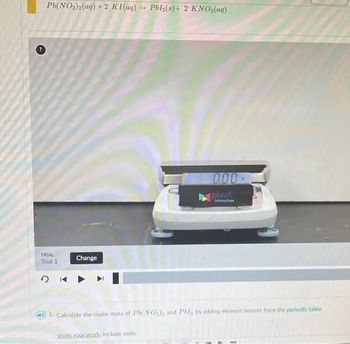
Chemistry
10th Edition
ISBN: 9781305957404
Author: Steven S. Zumdahl, Susan A. Zumdahl, Donald J. DeCoste
Publisher: Cengage Learning
expand_more
expand_more
format_list_bulleted
Concept explainers
Question
Calculate the molar mass of Pb(NO3)2 and PbI₂ by adding element masses from the periodic table. Show your work include units.

Transcribed Image Text:Pb(NO3)2(aq) + 2 KI(aq) → Pbl₂(s) + 2 KNO3(aq)
TRIAL
Trial 1
Change
000
show your work, include units.
pivot
interactives
COMM
41. Calculate the molar mass of Pb(NO) and Pbls by adding element masses from the periodic table.
Expert Solution
This question has been solved!
Explore an expertly crafted, step-by-step solution for a thorough understanding of key concepts.
This is a popular solution
Trending nowThis is a popular solution!
Step by stepSolved in 3 steps with 4 images

Knowledge Booster
Learn more about
Need a deep-dive on the concept behind this application? Look no further. Learn more about this topic, chemistry and related others by exploring similar questions and additional content below.Similar questions
- 1. A compound (molar mass= 324.41 g/mol) is used as a cardiac depressant. It has this percent composition by mass. 74.04% C; 7.46% H, 8.64% N; and 9.86% O. Use these data to determine the empirical formula and molecular formula of that compound. 2. Give the family name (i.e noble gas, halogen, alkali, or alkaline earth metal) for the following elements: I) Calcium II) Bromine III) Potassium IV) Barium V) Neonarrow_forwardDetermine the number of atoms of O in 56.2 moles of Al₂(CO₃)₃.arrow_forwardCalculate the molecular formula for the compound found to have the following elemental composition by mass: 40.0% C, 6.71% H, 53.3% O. The molar mass of the compound is 90.08 g/mol. I'm confused what to do next after acquiring the empirical formula mass.arrow_forward
- A certain chemical substance has the following percent composition by mass. Element Mass Percent carbon 25.29% hydrogen 3.891% bromine 56.08% nitrogen 14.75% Determine the empirical formula for the compound.Enter your answer without subscripts. C12H21Cl3 should be entered as C12H21Cl3. Enter elements in the order C, H, followed by the remaining elements alphabetically. Single elements do not need to have a subscript. CH4 should be entered as CH4, not C1H4.Empirical Formula: Answerarrow_forwardUse percent composition and molar mass to determine molecular formula. Analysis of a compound of carbon, hydrogen and oxygen showed that it is 52.13% C and 13.15% H, with O accounting for the remainder. In a separate experiment, the molar mass of the compound was found to be 46.08 g/mol. Determine the molecular formula of the compound. Enter the elements in the order C, H, O.arrow_forwardSample A 8.074 gram sample of an organic compound containing C, H and O is analyzed by combustion analysis and 20.88 grams of CO₂ and 4.274 grams of H₂O are produced. In a separate experiment, the molar mass is found to be 136.2 g/mol. Determine the empirical formula and the molecular formula of the organic compound. (Enter the elements in the order C, H, O.) Empirical formula: Molecular formula:arrow_forward
- What is the mass percent of each element in the fictitious compound X2Z4D. The molar masses of X, Z and D are 23.2 amu, 56.7 amu and 126.3 amu, respectively. Show your work and then place your final answers in the boxesarrow_forwardOne form of asbestos called chrysotile is considered to be a human carcinogen. Mass analysis shows that the composition of chrysotile is 26.3% Mg, 20.2% Si, 1.45% H, and the remainder of the mass is oxygen. Determine the empirical formula of chrysotile. ( Type in the formula without spaces or subscripts in the order it appears in the problem. As in Mg1Si2H3O4)arrow_forwardFor each group of three samples, determine the sample with the largest mass.arrow_forward
- 3. Determine mass percent of nitrogen and iron in Fe(NO3)3.arrow_forwardA 3.000 g sample of a gaseous compound was found to contain 2.560 g of carbon and 0.440 g of hydrogen. A) What is the simplest formula of the compound (Write C first and then H)? You won't be able to make the numbers a subscript. For instance, for MgCl2 enter MgCl2. B) The molar mass of the compound was found to be 42.08 g/mol. What is the molecular formula of the compound? You won't be able to make the numbers a subscript. For instance, for MgCl2 enter MgCl2.arrow_forwardCalculate the mass (in kilograms) of chlorine in 25 kg of chlorofluorocarbon (CFC). CFCl3arrow_forward
arrow_back_ios
SEE MORE QUESTIONS
arrow_forward_ios
Recommended textbooks for you
 ChemistryChemistryISBN:9781305957404Author:Steven S. Zumdahl, Susan A. Zumdahl, Donald J. DeCostePublisher:Cengage Learning
ChemistryChemistryISBN:9781305957404Author:Steven S. Zumdahl, Susan A. Zumdahl, Donald J. DeCostePublisher:Cengage Learning ChemistryChemistryISBN:9781259911156Author:Raymond Chang Dr., Jason Overby ProfessorPublisher:McGraw-Hill Education
ChemistryChemistryISBN:9781259911156Author:Raymond Chang Dr., Jason Overby ProfessorPublisher:McGraw-Hill Education Principles of Instrumental AnalysisChemistryISBN:9781305577213Author:Douglas A. Skoog, F. James Holler, Stanley R. CrouchPublisher:Cengage Learning
Principles of Instrumental AnalysisChemistryISBN:9781305577213Author:Douglas A. Skoog, F. James Holler, Stanley R. CrouchPublisher:Cengage Learning Organic ChemistryChemistryISBN:9780078021558Author:Janice Gorzynski Smith Dr.Publisher:McGraw-Hill Education
Organic ChemistryChemistryISBN:9780078021558Author:Janice Gorzynski Smith Dr.Publisher:McGraw-Hill Education Chemistry: Principles and ReactionsChemistryISBN:9781305079373Author:William L. Masterton, Cecile N. HurleyPublisher:Cengage Learning
Chemistry: Principles and ReactionsChemistryISBN:9781305079373Author:William L. Masterton, Cecile N. HurleyPublisher:Cengage Learning Elementary Principles of Chemical Processes, Bind...ChemistryISBN:9781118431221Author:Richard M. Felder, Ronald W. Rousseau, Lisa G. BullardPublisher:WILEY
Elementary Principles of Chemical Processes, Bind...ChemistryISBN:9781118431221Author:Richard M. Felder, Ronald W. Rousseau, Lisa G. BullardPublisher:WILEY

Chemistry
Chemistry
ISBN:9781305957404
Author:Steven S. Zumdahl, Susan A. Zumdahl, Donald J. DeCoste
Publisher:Cengage Learning

Chemistry
Chemistry
ISBN:9781259911156
Author:Raymond Chang Dr., Jason Overby Professor
Publisher:McGraw-Hill Education

Principles of Instrumental Analysis
Chemistry
ISBN:9781305577213
Author:Douglas A. Skoog, F. James Holler, Stanley R. Crouch
Publisher:Cengage Learning

Organic Chemistry
Chemistry
ISBN:9780078021558
Author:Janice Gorzynski Smith Dr.
Publisher:McGraw-Hill Education

Chemistry: Principles and Reactions
Chemistry
ISBN:9781305079373
Author:William L. Masterton, Cecile N. Hurley
Publisher:Cengage Learning

Elementary Principles of Chemical Processes, Bind...
Chemistry
ISBN:9781118431221
Author:Richard M. Felder, Ronald W. Rousseau, Lisa G. Bullard
Publisher:WILEY